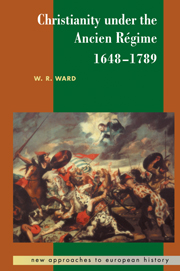Book contents
- Frontmatter
- Contents
- List of maps
- Preface
- Glossary
- 1 Peace and conflict: church and state in central and north-western Europe
- 2 Christianity in southern Europe
- 3 Catholicism in the Holy Roman Empire and the eastern Habsburg Lands
- 4 The religion of Protestants
- 5 Revival moves to the west
- 6 The Enlightenment and its precursors
- 7 The Churches in northern and eastern Europe
- 8 Religion after the Seven Years War
- Suggestions for further reading
- Index
- Title in the series
2 - Christianity in southern Europe
Published online by Cambridge University Press: 05 June 2012
- Frontmatter
- Contents
- List of maps
- Preface
- Glossary
- 1 Peace and conflict: church and state in central and north-western Europe
- 2 Christianity in southern Europe
- 3 Catholicism in the Holy Roman Empire and the eastern Habsburg Lands
- 4 The religion of Protestants
- 5 Revival moves to the west
- 6 The Enlightenment and its precursors
- 7 The Churches in northern and eastern Europe
- 8 Religion after the Seven Years War
- Suggestions for further reading
- Index
- Title in the series
Summary
Italy and the balance of power
The peace settlements of Westphalia, though designed to wind up a conflict in the Holy Roman Empire, also had their effect in southern Europe. Italy had been, and remained, the centre of the Counter-Reformation, and it had been one of the main bases of Spanish imperialism, the great political force behind the Counter-Reformation. That force had been intimately connected with the economic interests of the great Italian towns and ports, but it had been permanently damaged by the peace settlement. Spain remained dominant in the peninsula, could protect the route from Naples to Genoa and Milan, and overawe the Papal States. But the extension of that route through central Europe to the Netherlands had now been permanently severed, and Spain herself grievously weakened. Moreover Spain had now to face the reality of French power in the Italian peninsula. By the treaty of Cherasco France had acquired the fortress of Pinerolo and the adjacent Alpine valleys in Piedmont, and could quickly send a striking force into Italy. The minor Italian states (not to mention the College of Cardinals) lined up on one side or the other of this great-power divide, and dramatic results would have followed had not Louis XIV chosen to make his big drive eastwards rather than south-east.
- Type
- Chapter
- Information
- Christianity under the Ancien Régime, 1648–1789 , pp. 34 - 52Publisher: Cambridge University PressPrint publication year: 1999

